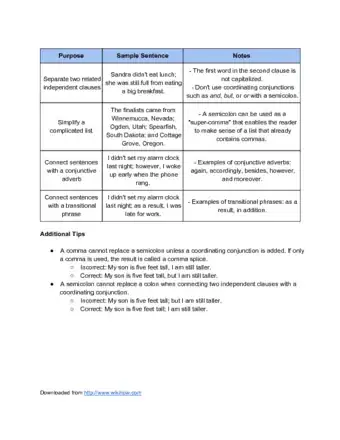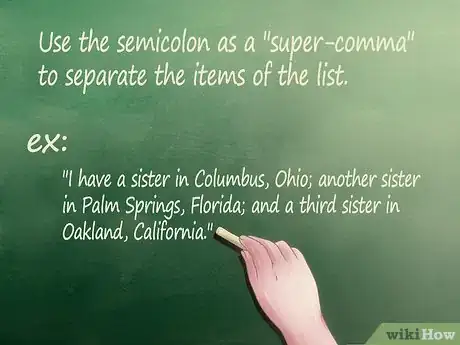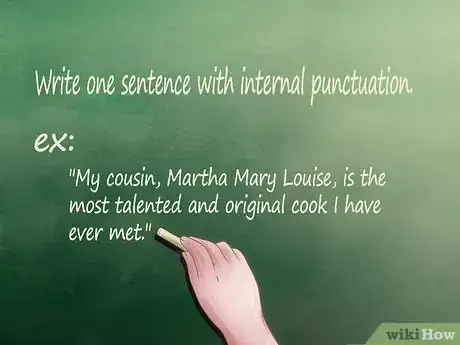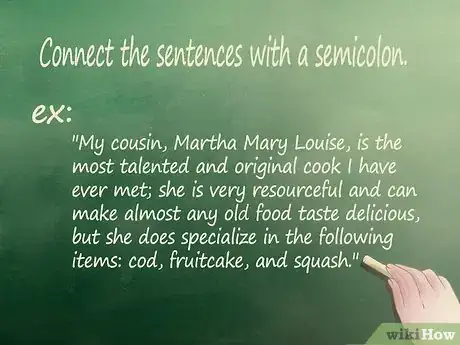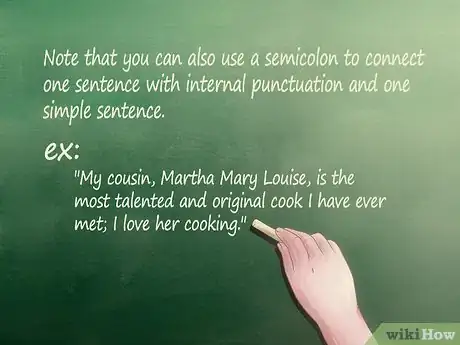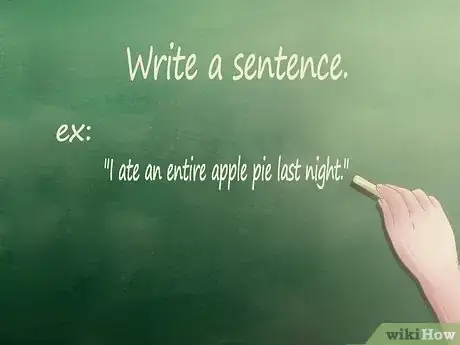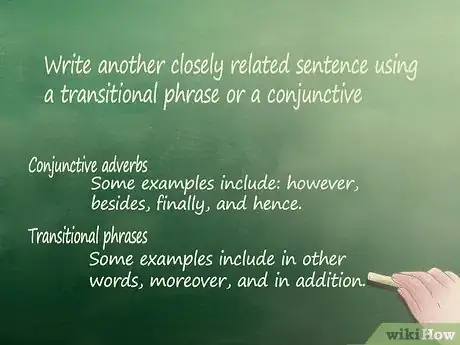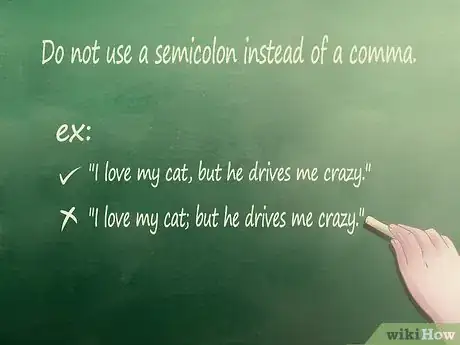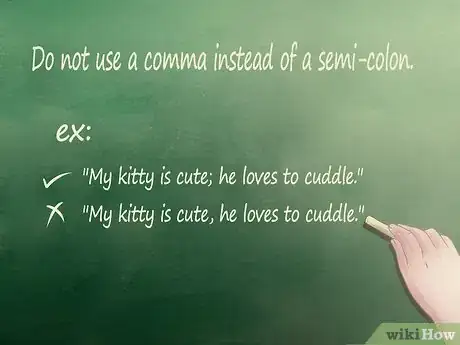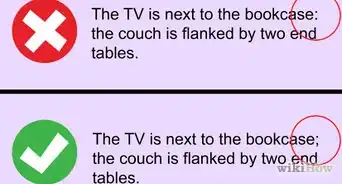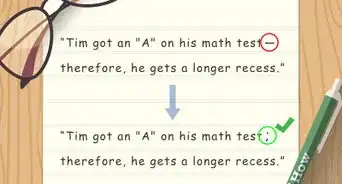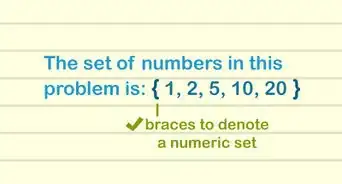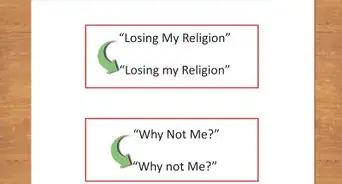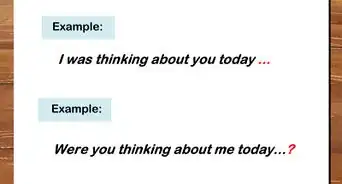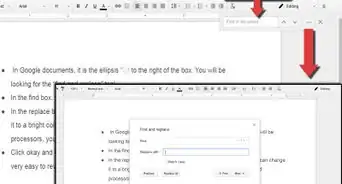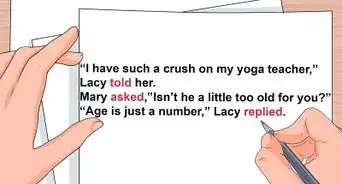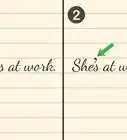This article was co-authored by Tristen Bonacci. Tristen Bonacci is a Licensed English Teacher with more than 20 years of experience. Tristen has taught in both the United States and overseas. She specializes in teaching in a secondary education environment and sharing wisdom with others, no matter the environment. Tristen holds a BA in English Literature from The University of Colorado and an MEd from The University of Phoenix.
There are 8 references cited in this article, which can be found at the bottom of the page.
wikiHow marks an article as reader-approved once it receives enough positive feedback. In this case, 90% of readers who voted found the article helpful, earning it our reader-approved status.
This article has been viewed 422,007 times.
The semicolon can connect closely related ideas, spice up your writing, and make your sentences sound more sophisticated—if you use it correctly. If you'd like to know how to use the tricky semicolon the right way, just follow these easy steps.
Semicolon Usage Chart
Steps
Linking Two Sentences
-
1Write one complete sentence. A complete sentence must contain a subject and a verb and be a complete thought. The subject is the person, place, or thing that the sentence is about, and the verb is the action that is being performed in the sentence.
- Ex: "Wanda couldn't fall asleep last night."
-
2Write another closely related sentence. This sentence must be strongly related to the first sentence for the semicolon to work.[1]
- Ex: "She had too much on her mind."
Advertisement -
3Connect the sentences with a semicolon. Remember to make the first letter of the second sentence lowercase.[2]
- Ex: "Wanda couldn't fall asleep last night; she had too much on her mind." A semicolon is used in parallel construction.[3]
Tip: You can treat a semicolon as a period to connect two closely related sentences. This means that you can replace any semicolon with a period.
Linking Items in a List
-
1Write a sentence that contains a complicated list. Each item in the sentence should contain commas, and each item should also be separated by commas.[4]
- Ex: "I have a sister in Columbus, Ohio, another sister in Palm Springs, Florida, and a third sister in Oakland, California."
-
2Use the semicolon as a "super-comma" to separate the items of the list. This will make it easier to distinguish between the items in the list.[5]
- Ex: "I have a sister in Columbus, Ohio; another sister in Palm Springs, Florida; and a third sister in Oakland, California."
Linking Sentences with Internal Punctuation
-
1Write one sentence with internal punctuation. This sentence can use a colon, dash, or comma. Sentences with internal punctuation tend to be longer. Using semicolons to separate sentences with internal commas is the most common method.[6]
- Ex: "My cousin, Martha Mary Louise, is the most talented and original cook I have ever met."
-
2Write another closely related sentence with internal punctuation.[7]
- Ex: "She is very resourceful and can make almost any old food taste delicious, but she does specialize in the following items: cod, fruitcake, and squash."
-
3Connect the sentences with a semicolon.[8]
- Ex: "My cousin, Martha Mary Louise, is the most talented and original cook I have ever met; she is very resourceful and can make almost any old food taste delicious, but she does specialize in the following items: cod, fruitcake, and squash."
-
4Note that you can also use a semicolon to connect one sentence with internal punctuation and one simple sentence.
- Ex: "My cousin, Martha Mary Louise, is the most talented and original cook I have ever met; I love her cooking."
Linking Sentences with a Transitional Phrase or Conjunctive Adverb
-
1Write a sentence. You can keep it simple.
- Ex: "I ate an entire apple pie last night."
-
2Write another closely related sentence using a transitional phrase or a conjunctive adverb.[9]
- Conjunctive adverbs are words that show a relationship between the two sentences, such as cause and effect, contrast, or comparison. Some examples include: however, besides, finally, and hence.[10]
-
Transitional phrases are used to move from one sentence to the next in a logical and smooth way. Some examples include in other words, moreover, and in addition.
- Ex: "As a result,' I felt sick when I woke up."
-
3Connect the two with a semicolon.[11]
- Ex: "I ate an entire apple pie last night; as a result, I felt sick when I woke up."
Avoid Confusing the Semicolon with the Comma
-
1Do not use a semicolon instead of a comma. Commas can be used to connect two simple sentences and a coordinating conjunction (but, and, nor, or so, for example), while a semicolon cannot.[12]
- Example of correct usage: "I love my cat, but he drives me crazy."
- Example of incorrect usage: "I love my cat; but he drives me crazy."
-
2Do not use a comma instead of a semi-colon. A comma can never be used to separate two independent clauses (complete sentences). This is called a comma splice and should be avoided at all times.[13]
- Example of correct usage: "My kitty is cute; he loves to cuddle."
- Example of incorrect usage: "My kitty is cute, he loves to cuddle."
Expert Q&A
-
QuestionHow do you use a semicolon in an example?
 Tristen BonacciTristen Bonacci is a Licensed English Teacher with more than 20 years of experience. Tristen has taught in both the United States and overseas. She specializes in teaching in a secondary education environment and sharing wisdom with others, no matter the environment. Tristen holds a BA in English Literature from The University of Colorado and an MEd from The University of Phoenix.
Tristen BonacciTristen Bonacci is a Licensed English Teacher with more than 20 years of experience. Tristen has taught in both the United States and overseas. She specializes in teaching in a secondary education environment and sharing wisdom with others, no matter the environment. Tristen holds a BA in English Literature from The University of Colorado and an MEd from The University of Phoenix.
Licensed English Teacher An example of a semicolon in a sentence could be "I love bananas; I love apples." This uses parallel construction—in other words, you have the same thing on both sides of the semicolon (a subject and a verb).
An example of a semicolon in a sentence could be "I love bananas; I love apples." This uses parallel construction—in other words, you have the same thing on both sides of the semicolon (a subject and a verb). -
QuestionCan you use a semicolon instead of ", but"?
 Community AnswerYou can use a semicolon followed by "however,". A semicolon alone would not provide the indication that you are about to contrast something with what you just said, and you need to provide that indication.
Community AnswerYou can use a semicolon followed by "however,". A semicolon alone would not provide the indication that you are about to contrast something with what you just said, and you need to provide that indication. -
QuestionWhat is the difference between a hyphen and a dash?
 DonaganTop AnswererHyphens connect words to each other. Dashes are used to add emphasis or indicate a pause in thought.
DonaganTop AnswererHyphens connect words to each other. Dashes are used to add emphasis or indicate a pause in thought.
References
- ↑ Tristen Bonacci. Licensed English Teacher. Expert Interview. 21 December 2021.
- ↑ https://www.grammarly.com/blog/semicolon/
- ↑ Tristen Bonacci. Licensed English Teacher. Expert Interview. 21 December 2021.
- ↑ https://www.niu.edu/writingtutorial/punctuation/semicolon.shtml
- ↑ https://www.adelaide.edu.au/writingcentre/ua/media/56/learningguide-semicolons.pdf
- ↑ https://www.niu.edu/writingtutorial/punctuation/semicolon.shtml
- ↑ https://www.adelaide.edu.au/writingcentre/ua/media/56/learningguide-semicolons.pdf
- ↑ https://writing.wisc.edu/handbook/grammarpunct/semicolons/
- ↑ https://www.butte.edu/departments/cas/tipsheets/punctuation/semicolon.html
- ↑ Tristen Bonacci. Licensed English Teacher. Expert Interview. 21 December 2021.
- ↑ https://www.niu.edu/writingtutorial/punctuation/semicolon.shtml
- ↑ https://owl.purdue.edu/owl/general_writing/punctuation/commas/commas_vs_semicolons.html
- ↑ https://www.iup.edu/writingcenter/writing-resources/punctuation/comma-splices.html
About This Article
The most common way to use a semicolon is to link two complete sentences rather than separating them by a period, whether they are simple sentences, contain internal punctuation, or are connected with a transitional phrase or conjunctive adverb such as “however,” “besides,” “finally,” or “in addition.” You can also use a semicolon to separate items in a complex list when the individual items contain punctuation. If you want to learn when to use a semicolon instead of using a comma, keep reading the article!
